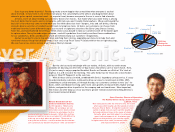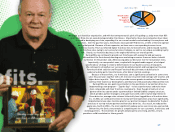Sonic 2004 Annual Report Download - page 17
Download and view the complete annual report
Please find page 17 of the 2004 Sonic annual report below. You can navigate through the pages in the report by either clicking on the pages listed below, or by using the keyword search tool below to find specific information within the annual report.
After remaining flat during fiscal year 2003, food and packaging costs increased, as a
percentage of Partner Drive-In sales, 0.3% during fiscal year 2004 as a result of higher unit
level costs for most commodities,which offset the benefit of price increases taken during
the year. The pressure on commodity prices is expected to continue for the next several
months and as a result we expect our food and packaging costs, as a percentage of sales,
will continue to be higher on a year-over-year basis.
Labor costs increased, as a percentage of Partner Drive-In sales, 0.6% during fiscal
year 2004 following a 0.9% increase in fiscal year 2003. The 2004 increase was primarily a
result of significant payments made under a new sales incentive bonus program for
drive-in management as well as higher staffing levels reflecting successful ongoing
efforts to reduce turnover at Partner Drive-Ins. The increase during 2003 primarily
resulted from increased investment in store-level labor, particularly assistant managers, as
well as higher worker’s compensation and health insurance costs.
Looking forward, we will continue to benefit from a relatively flat average wage rate
and we expect to continue making significant payments under our sales incentive
program. However, we will be modifying the program to add a profit qualifier to enhance
flow-through from the incremental sales. As a result of that change and lapping the
beginning of the sales incentive bonus program that began in September 2003, the
opportunity to leverage labor costs, as a percentage of sales, during the next fiscal year is
more favorable.
Minority interest, which reflects our store-level partners’ pro-rata share of earnings
from our partnership program, increased by $5.5 million during fiscal year 2004 as the
increase in average dollar profit per store more than offset the decline in drive-in-level
margins. During fiscal year 2003, lower average unit profits combined with declining
drive-in-level margins resulted in a $0.5 million decrease in minority interest. Overall, we
continue to view the partnership program as an integral part of our culture at Sonic and
a large factor in the success of our business, and we are pleased that profit distributions
to our partners increased during fiscal year 2004. Since we expect our average store level
profits to continue to grow in fiscal year 2005 and we expect less margin pressure, we
would expect minority interest to increase in real terms but stay relatively flat as a
percentage of sales.
Other operating expenses improved, as a percentage of Partner Drive-In sales, by
0.1% during fiscal year 2004 as the leverage of operating at higher unit volumes more
than offset increased costs. In real dollar terms, the increase in other operating expenses
in fiscal year 2004 was comprised of several factors including higher marketing
expenditures, utilities, credit card charges resulting from an increase in customer credit
card usage,and a fairly sharp increase in repair and maintenance expense as we have
focused on the physical appearance of our stores, both inside and out. While we expect
cost increases in many of the items listed above to carry over into fiscal year 2005, we
anticipate that the benefit of operating at higher unit volumes will lead to an
improvement in other operating expenses, as a percentage of sales, over the next few
quarters. During fiscal year 2003, other operating expenses, as a percentage of Partner
Drive-In sales,deteriorated 0.5% primarily as a result of the lack of growth in average store
volumes, an increase in the rate of advertising contributions in preparation for the
breakfast rollout and rent expense related to the acquisition of Franchise Drive-Ins where
the franchisee retained the real estate.
Selling, General and Administrative. Selling, general and administrative expenses
increased 8.0% to $38.3 million during fiscal year 2004 and 5.9% to $35.4 million during
fiscal year 2003. However, we continue to see leverage as the growth in these expenses
was considerably less than the growth in revenues. As a percentage of total revenues,
selling, general and administrative expenses decreased to 7.1% in fiscal year 2004,
compared with 7.9% in fiscal year 2003 and 8.4% in fiscal year 2002. We anticipate that
these costs will increase in the range of 10% to 12% in fiscal year 2005 but expect them
to continue to decline as a percentage of total revenues.
Depreciation and Amortization. Depreciation and amortization expense increased
11.3% to $32.5 million in fiscal year 2004 due, in part, to additional depreciation
stemming from the San Antonio and Colorado acquisitions,as well as the capital lease on
our new corporate office space. Similarly, depreciation and amortization expense
increased 12.1% to $29.2 million in fiscal year 2003 as a result of new drive-in
development and acquisitions of existing Franchise Drive-Ins. Capital expenditures,
excluding acquisitions, were $57.7 million in fiscal year 2004. Looking forward, with $60
to $70 million in capital expenditures planned for fiscal year 2005,we expect depreciation
and amortization to increase in the range of 8% to 9% for the year.
Provision for Impairment of Long-lived Assets.One Partner Drive-In became impaired
during fiscal year 2004 under the guidelines of FAS 144 – “Accounting for the Impairment
or Disposal of Long-Lived Assets.” As a result, a provision for impairment of long-lived
assets of $0.7 million was recorded for the drive-in’s carrying cost in excess of its
estimated fair value. Two Partner Drive-Ins became impaired during fiscal year 2003
which resulted in a provision for impairment of $0.7 million to reduce the drive-ins’
carrying cost to their estimated fair value. During fiscal year 2002, two Partner Drive-Ins
became impaired and estimates were revised on two stores that were previously
impaired, resulting in a provision for impairment of $1.3 million. We continue to perform
quarterly analyses of certain underperforming drive-ins. It is reasonably possible that the
estimate of future cash flows associated with these drive-ins may change in the near
future resulting in the need to write-down assets associated with one or more of these
drive-ins to fair value.
Interest Expense.Net interest expense increased 2.6% in fiscal year 2004 compared to
a 1.6% decrease in fiscal year 2003. While interest expense increased in fiscal year 2004
largely due to the addition of the capital lease associated with our new office space, a
continued favorable interest rate environment combined with the refinancing of $20
Management's Discussion and Analysis of Financial Condition and Results of Operations
p.15
























